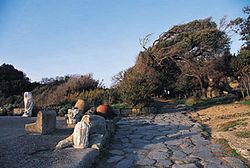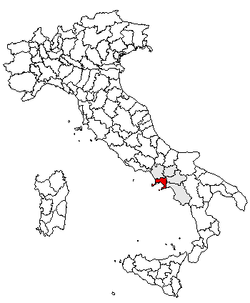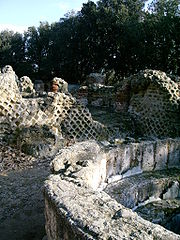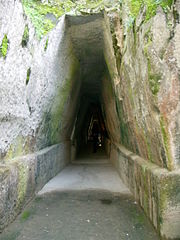- Cumae
-
For other places with the same name, see Cuma (disambiguation).
Cumae (Italian: Italian: Cuma, Ancient Greek: Greek: Κύμη Kūmē, Κύμαι Kūmai or Κύ̂μα Kūma[1]) is an ancient Greek settlement lying to the northwest of Naples in the Italian region of Campania. Cumae was the first Greek colony on the mainland of Italy (Magna Graecia), and the seat of the Cumaean Sibyl. It was the Cumaean alphabet that was adopted in Italy, first by the Etruscans (800 - 100 B.C.E.) and then by the Romans(300 - 100 B.C.E.), thus becoming the Latin alphabet, the world's most widely used phonemic script. The Cumaean alphabet was also used throughout the Greek island of Euboea.
Today Cuma - Fusaro is a frazione of the comune of Bacoli.
Contents
Early history
The settlement, in a location that was already occupied, is believed to have been founded in the 8th century BC[2] by Euboean Greeks, originally from the cities of Eretria and Chalcis in Euboea, who were already established at Pithecusae (modern Ischia); they were led by the paired oecists (colonizers) Megasthenes of Chalcis and Hippocles of Cyme.[3]
The Greeks were planted upon the earlier dwellings of indigenous, Iron-Age peoples whom they supplanted; a memory of them was preserved as cave-dwellers named Cimmerians, among whom there was already an oracular tradition.[4] Its name refers to the peninsula of Cyme in Euboea. The colony was also the entry point in the Italian peninsula for the Euboean alphabet, the local variant of the Greek alphabet used by its colonists, a variant of which was adapted by the Romans and became the Latin alphabet still used worldwide today.
Cumae was a direct offshoot of an earlier colony on the nearby island of Ischia, Pithecusae,[5] founded by colonists from the Euboean cities of Eretria and of Chalcis (Χαλκίς), which was accounted its mother-city by agreement among the first settlers.[6]
The colony thrived. By the eighth century it was strong enough to send Perieres and a group with him, who were among the founders of Zancle in Sicily, and another band had returned to found Triteia in Achaea, Pausanias was told.[7] It spread its influence throughout the area over the seventh and sixth centuries BC, gaining sway over Puteoli and Misenum and, thereafter, founding Neapolis in 470 BC. All these facts were recalled long afterwards; Cumae's first brief contemporary mention in written history is in Thucydides.
The growing power of the Cumaean Greeks led many indigenous tribes of the region to organize against them, notably the Dauni and Aurunci with the leadership of the Capuan Etruscans. This coalition was defeated by the Cumaeans in 524 BC under the direction of Aristodemus, called Malacus, a successful man of the people who overthrew the aristocratic faction, became a tyrant himself, and was assassinated.[8]
Contact between the Romans and the Cumaeans is recorded during the reign of Aristodemus. Livy states that immediately prior to the war between Rome and Clusium, the Roman senate sent agents to Cumae to purchase grain in anticipation of a siege of Rome. [9] Also Lucius Tarquinius Superbus, the last legendary King of Rome, lived his life in exile with Aristodemus at Cumae after the establishment of the Roman Republic.[10]
Also during the reign of Aristodemus, the Cumaean army assisted the Latin city of Aricia to defeat the Etruscan forces of Clusium.
The combined fleets of Cumae and Syracuse defeated the Etruscans at the Battle of Cumae in 474 BC.
Oscan and Roman Cumae
The Temple of Zeus at Cumae was converted into a paleochristian basilica Entrance to the Cave of the Sibyl
Entrance to the Cave of the Sibyl
The Greek period at Cumae came to an end in 421 BC, when the Oscans broke down the walls and took the city, ravaging the countryside. Some survivors fled to Neapolis.[11] Cumae came under Roman rule with Capua and in 338 was granted partial citizenship, a civitas sine suffragio. In the Second Punic War, in spite of temptations, Cumae withstood Hannibal's siege, under the leadership of Tib. Sempronius Gracchus.[12]
Under Roman rule "quiet Cumae" slumbered until the disasters of the Gothic Wars, when it was repeatedly attacked, as the only fortified city in Campania aside from Neapolis: Belisarius took it in 536, Totila held it, and when Narses gained possession of Cumae, he found he had won the whole treasury of the Goths. In 1207, forces from Naples, acting for the boy-King of Sicily, destroyed the city and its walls, as the stronghold of a nest of bandits.
The Sibyl of Cumae
Main article: Cumaean SibylCumae is perhaps most famous as the seat of the Cumaean Sibyl. Her sanctuary is now open to the public.
In Roman mythology, there is an entrance to the underworld located at Avernus, a crater lake near Cumae, and was the route Aeneas used to descend to the Underworld.
The Temple of Zeus at Cumae was transformed into a Christian basilica at the end of the fourth century. At Cumae was set a widely influential Christian work of the second century, The Shepherd of Hermas said by its author to have been inspired by way of visions.
The colony was built on a large rise, the seaward side of which was used as a bunker and gun emplacement by the Germans during World War II.
Notes and references
- ^ Perseus: Κύ̂μα
- ^ Eusebius of Caesarea placed Cumae's Greek foundation at 1050 BC; modern archaeology has not detected the first settlers' graves, but fragments of Greek pottery ca 750-40 have been found by the city wall (Robin Lane Fox, Travelling Heroes in the Epic Age of Homer, 2008:140).
- ^ Lane Fox 2008:140 notes that whether the Euboeans were from the Ischian colony or freshly arrived is a moot question
- ^ Strabo, v.5, noted in Elizabeth Hazelton Haight, "Cumae in Legend and History" The Classical Journal 13.8 (May 1918:565-578) p. 567.
- ^ Livy, viii.22.
- ^ Strabo, v.4.
- ^ Pausanias, vii.22.6.
- ^ Dionysius of Halicarnassus, vii.3; Plutarch tells the story of Xenocrite, the girl who roused the Cumaeans against Aristodemus, in De mulierum virturibus 26.
- ^ Livy, Ab urbe condita, 2.9
- ^ Livy, ii.21; Cicero, Tusculan Disputations iii.27.
- ^ Livy, iv.44; Diodorus Siculus, xii. 76.
- ^ Livy, xxiii.35-37.
See also
External links
- YouTube video of Cuma from Napoli Underground.
- "Cuma" in Around Naples Encyclopedia.
- Blog of Cumae.
Coordinates: 40°50′55″N 14°03′13″E / 40.84861°N 14.05361°E
Categories:- Euboean colonies of Magna Graecia
- Populated places established in the 8th century BC
- Archaeological sites in Italy
- Buildings and structures in Campania
- Ancient Greek cities
- Former populated places in Italy
Wikimedia Foundation. 2010.




